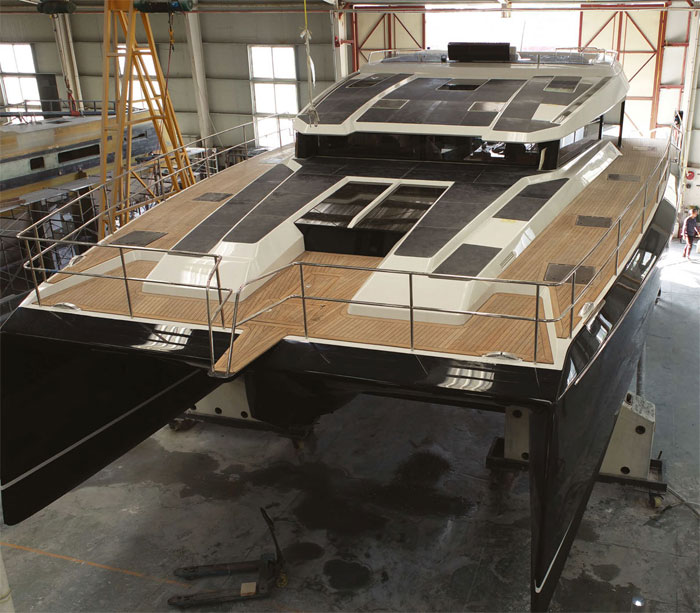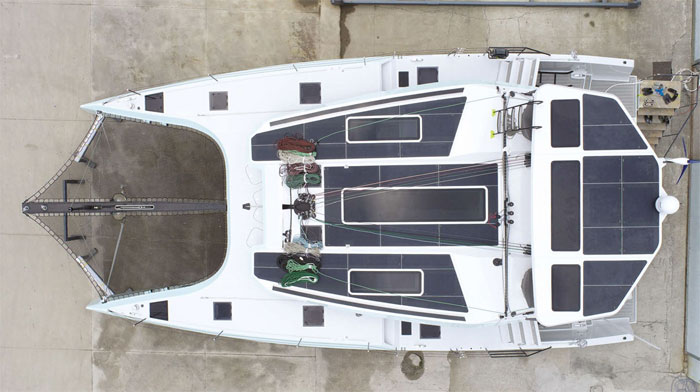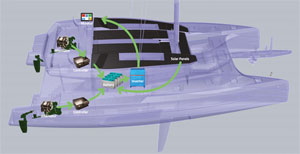

From fast charging systems and photovoltaic glass to the next generation of hydrogen fuel cell technology, McConaghy Boats is pushing the boundaries of sustainable marine power solutions
On the face of it, sailboats provide a head start when it comes to going green. And yet despite the number of ways in which hydro and wind generated power has already been achieved across both racing and cruising craft of all sizes for many years, stepping things up to the next stage of emission free systems is proving to be more taxing than many had originally anticipated. McConaghy Boats are further down the line in this area than many.

All McConaghy catamarans have a huge amount of horizontal surface area where solar panels can be mounted
They see the road to success as involving a number of stages that are based around combining a range of techniques rather than holding out for a single solution. The company also has several clear advantages both in the type of boats that they are famous for and their acknowledged experience with highperformance composites. In particular, McConaghy’s range of luxury performance cruising cats has not only grown considerably over the years, but has drawn a great deal of attention thanks to their looks and performance.
So, when it comes to generating green power, cats of the type that McConaghy build start with two key strengths, performance is the first.
Speed is clearly important when considering hydro-generation and the McConaghy range is well known for its impressive performance. Building lightweight boats is key and here McConaghy’s long-held expertise in building advanced carbon structures places them well ahead.
‘Building light is the starting point because when it comes to propulsion systems it means you need less horsepower to start with, which in turn means less wastage and of course more performance,’ says McConaghy Boats’ CEO Mark Evans.
The second significant advantage of a cat is size. By their very nature, cats have plenty of surface area for installing solar panels when compared with an equivalent length monohull. So it’s little surprise that across the McConaghy range of seven sailing cats from the MC55 to the MC115 solar power generation has proved popular.
‘We buy the best solar solutions that are available and basically we cover the yacht and most of the horizontal surfaces with the solar panels,’ Evans continues. ‘When it comes to research on what’s available on the solar panel market and how it performs, we’ve done a great deal of work in this area to the point that we consider ourselves to be experts in this field. There’s a wide range of solar products out there and identifying the right panels for the job is not always that straightforward. Some of them are more efficient than others due to heat transfer and then there’s the issue of ensuring that their specific application means that they don’t overheat and so on. But, 90 per cent of the boats that we produce are now fully covered with solar panels. To include solar panels has now become the norm which is certainly a step forward.’
But for McConaghy the work doesn’t stop here when it comes to additional ways in which power can be generated. Instead, the company has taken the quest for green power further by considering and employing a range of innovative and advanced techniques as well as a major step forward that could prove to be a complete game changer.
‘Everybody's pushing us for green solutions,’ says Evans. ‘One of the ways that has been popular so far is to use Integrel systems, which are fast charging 48 volt systems that can generate up to six kilowatts per engine. This means that when you're motoring you can push 12kW back into the batteries, way more than what most boats achieve. The system is basically like a big alternator hanging off the side of the engine.

‘Using the main engines like this means that you're not wasting the power but you're generating electricity and putting it back into the system. Around 50 per cent of our clients are now taking this fast charging system. It also means you can make savings when it comes to the main generator which can be smaller and cater for just the house loads. Then, when you need to ramp things up you've got two other generators with the main engines. So, even just at this level, with the presence of solar power you do have a lot of means of putting power back into the boat.’
McConaghy is also using an increasing amount of solar photovoltaic (PV) glass aboard their boats which allow the windows to act as solar panels too. ‘The glass that we buy for skylights and windows has a built-in solar membrane. You can still see through the glass, but with this technology the glass now becomes a solar panel as well. I would say around a 50 per cent of our clients are taking the solar glass option,’ he continues. ‘You can get different levels of efficiency and while this glass is a lot less efficient than solar panels, when you add this into the overall equation you can start to see a path towards a fully green yacht.’
But despite this significant progress, the company is working on a bigger project that Evans says could be a game changer. The system is currently in development and he’s reluctant to give away too many details at this stage, but when pressed he confirmed that the basis of the next generation of power supply is around hydrogen fuel cells.
Those that have followed McConaghy’s recent projects around the America’s Cup world may not be surprised to hear this given that the company was so closely involved with Emirates Team New Zealand’s hydrogen-powered foiling chase boat. From an emissions point of view the benefits of hydrogen fuel cells are well known, namely that water is the only waste product. From a technical point of view, hydrogen fuel cells are far more efficient than straightforward electrical batteries that, by comparison, have far less energy density making them a much heavier solution for the same amount of power.
‘From many points of view, especially when it comes to emissions, hydrogen fuel cells offer big benefits. But there are also a number of key issues that make this technology hard to apply when it comes to blue water cruising boats,’ he says.
‘One issue is the need to store hydrogen at high pressure, around 350-720bar which means some highly sophisticated and expensive engineering. But from our experience it’s also not that appealing to our cruising clients. Another issue is that of availability. While hydrogen is used widely in industry and available in developed parts of the world, it’s very difficult if not impossible to get it in less populated areas. But we believe there is a way of achieving an efficient hydrogen fuel cell that overcomes these issues that will really open up the possibilities.’
So how far away are we talking?
‘To get to the point of being able to prove the concept I’d say around another six months,’ he says. ‘The fact is that while this will represent a big step forward, the technology is already out there and well proven in other fields. What we are doing is showing that it can be applied on a different, smaller scale and all our work makes us believe firmly that it can be.
‘As we’ve shown with our work with integrated systems and solar panels we believe that the route forwards is via incremental change. As a result, in this case it may well be that to start with, the main propulsion system remains as a diesel, but the goal with this new technology would be to phase this out eventually. And once we’ve proved the concept, I’m pretty sure that will happen quickly because unlike the high-pressure hydrogen route, our system will allow us to store hydrogen at much lower pressures which in turn makes the entire system more manageable and scalable.

McConaghy cruising cats are renowned for their distinctive styling as well as their excellent performance under sail
‘Having said that, because of the weight of the system there will likely be some practical restrictions on just how small you can go, but for our range of boats I see few issues here. Overall, the work we’ve done shows that there is no reason why we shouldn’t be powering the entire boat with this new technology and that is really exciting.’
Meanwhile, and aside from the leadingedge developments when it comes to power generation, McConaghy’s core business still revolves around creating high-quality performance boats.
‘Whatever the final choice when it comes to power, we're still creating an advanced platform for our customers to create a custom-built boat where owners can change the layout, specify individual finishes and create the unique boat that they’re after. We work very, very closely with them on every single detail.
‘Yet among all this choice and the wide variety of layouts and styles that emerge when boats hit the water, when it comes to the future of power and the need to go green, the overwhelming majority of our clients are on the same page and moving in the same direction.’
Click here for more information on McConaghy Boats »
We invite you to read on and find out for yourself why Seahorse is the most highly-rated source in the world for anyone who is serious about their racing.
To read on simply SIGN up NOW
Take advantage of our very best subscription offer or order a single copy of this issue of Seahorse.
Online at:
www.seahorse.co.uk/shop and use the code TECH20
Or for iPad simply download the Seahorse App at the iTunes store


